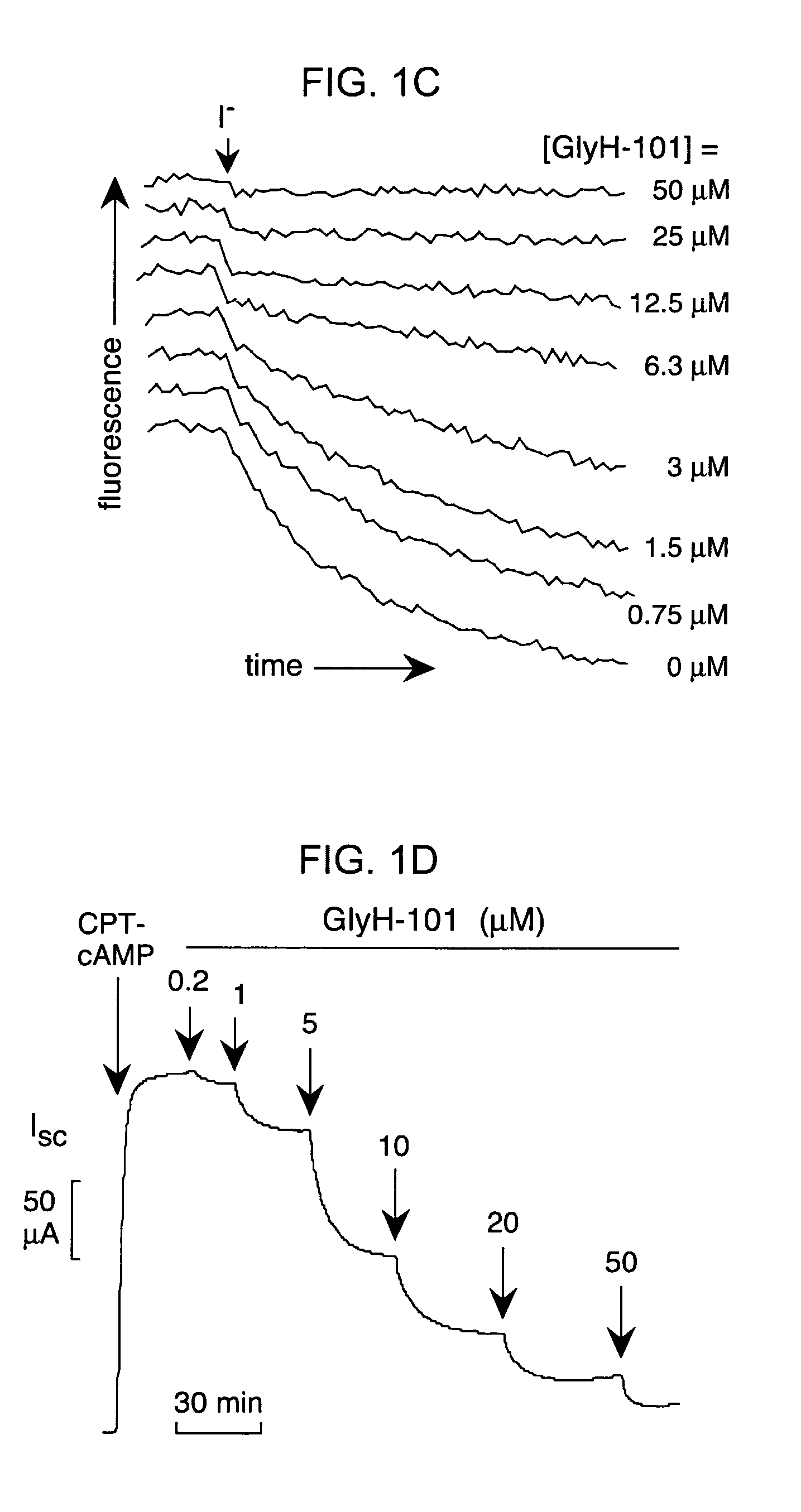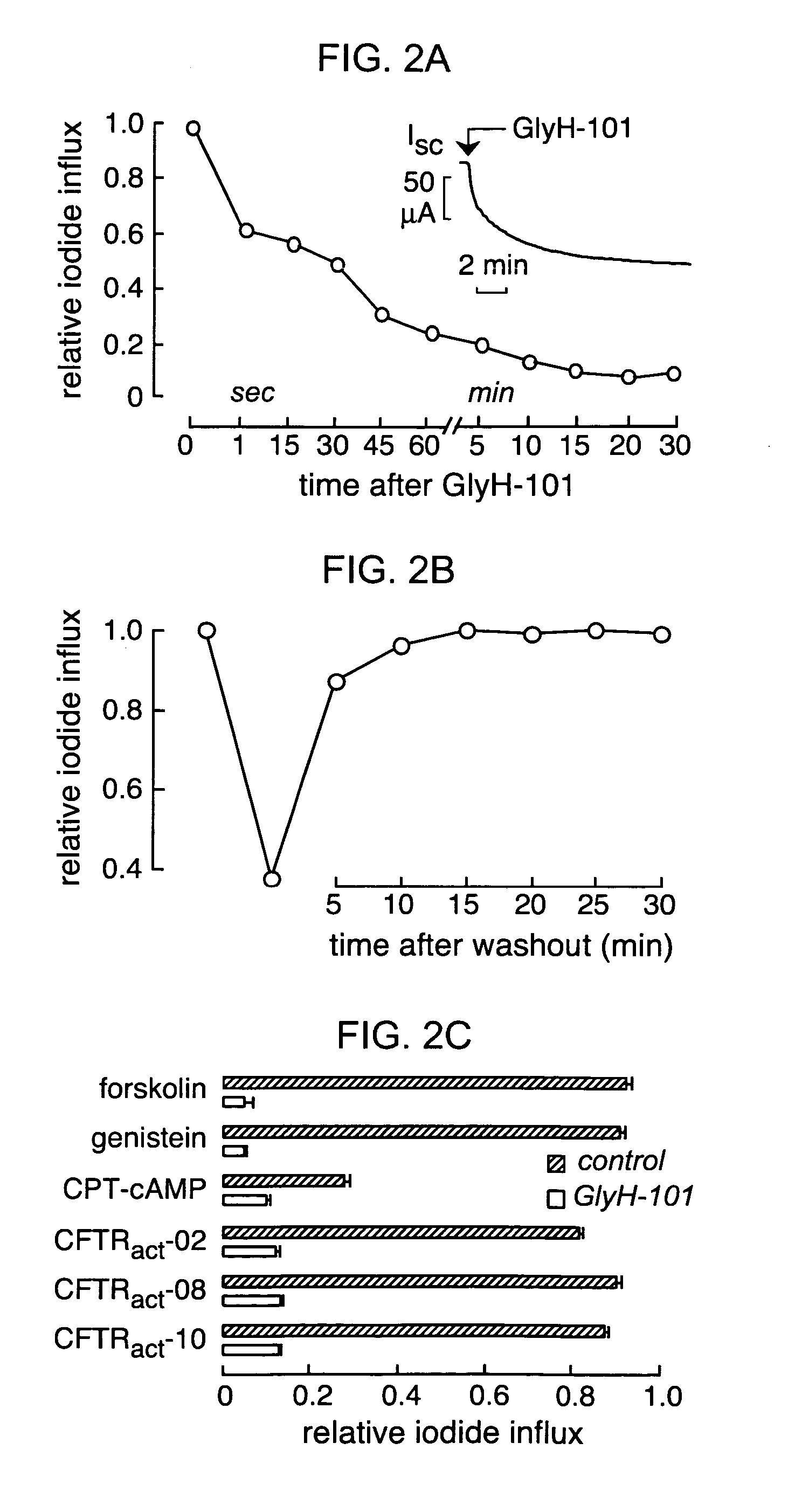Hydrazide-containing CFTR inhibitor compounds and uses thereof
a technology of cftr and inhibitor compounds, which is applied in the field of hydrozide-containing cftr inhibitor compounds, can solve the problems of inadequacies of cf mouse models, little or no airway disease, morbidity and mortality, etc., and achieve the effect of inhibiting cftr
- Summary
- Abstract
- Description
- Claims
- Application Information
AI Technical Summary
Benefits of technology
Problems solved by technology
Method used
Image
Examples
example 1
Discovery of Novel Classes of CFTR Inhibitors
[0222]A collection of 100,000 small, drug-like compounds was screened to identify new CFTR inhibitors. As diagrammed in FIG. 1A, compounds were screened at 25 μM in a cell-based assay of iodide influx after CFTR activation by an agonist mixture containing forskolin, IBMX and apigenin. Initial rates of iodide influx were computed from the kinetics of fluorescence decrease following chloride replacement by iodide. Four compounds (FIG. 1B) reducing iodide influx by greater than 50% were identified, which were not related structurally to known CFTR activators or inhibitors. Twelve compounds reduced iodide influx by 25-50%, most of which were related structurally to the compounds in FIG. 1B or to the thiazolidinones.
[0223]To select inhibitor(s) for further evaluation, dose-response measurements were done for the compounds in FIG. 1B, and CFTR inhibition was confirmed electrophysiologically by short-circuit current analysis. Ki was ˜7, 5, 5 and...
example 2
Chemistry and Structure-activity Relationships of Glycine Hydrazides
[0225]The GlyH-101 structure was modified systematically to establish structure-activity relationships and to identify analogs with improved CFTR inhibitory activity. FIG. 3A shows the various classes of structural analogues that were synthesized and tested for CFTR inhibition. Structural modifications were performed on both ends of the glycine hydrazide backbone (FIG. 3A, left, top and middle). Replacing the glycine methylene group by a carbonyl group and replacing nitrogen by oxygen generated oxamic acid hydrazides (OxaH, right, top) and acetic acid hydrazides (AceH, right, middle), respectively. The hydrazone group modification produced two important series of compounds (middle, bottom and right, bottom). Also shown are compounds containing an additional methyl group at the hydrazone bond (top, middle), and containing a 6-qunolinyl group replacing the naphthalenyl group (left, bottom).
[0226]FIG. 3B shows the reac...
example 3
Patch-Clamp Analysis of CFTR Inhibition Mechanism
[0234]The mechanism of CFTR block by GlyH-101 was studied using the whole-cell configuration of the patch-clamp technique. After maximal activation of CFTR in stably transfected FRT cells by 5 μM forskolin, current-voltage relationships were measured at GlyH-101 concentrations from 0 to 50 μM. Representative original current recordings are shown in FIG. 4A. In the absence of inhibitor (left panel), membrane current increased linearly with voltage and did not show relaxation phenomena, as expected for pure CFTR Cl− currents. Extracellular perfusion with 10 μM GlyH-101 produced an immediate reduction in current that was strongly dependent on membrane potential (FIG. 4A, right panel). At more positive membrane potentials outward positive currents (Cl− movement into the cell) were reduced compared to inward currents. FIG. 4B shows current-voltage relationships for GlyH-101 concentrations of 0 (control), 10 and 30 μM, and after washout of ...
PUM
| Property | Measurement | Unit |
|---|---|---|
| voltages | aaaaa | aaaaa |
| voltages | aaaaa | aaaaa |
| wavelengths | aaaaa | aaaaa |
Abstract
Description
Claims
Application Information
 Login to View More
Login to View More - R&D
- Intellectual Property
- Life Sciences
- Materials
- Tech Scout
- Unparalleled Data Quality
- Higher Quality Content
- 60% Fewer Hallucinations
Browse by: Latest US Patents, China's latest patents, Technical Efficacy Thesaurus, Application Domain, Technology Topic, Popular Technical Reports.
© 2025 PatSnap. All rights reserved.Legal|Privacy policy|Modern Slavery Act Transparency Statement|Sitemap|About US| Contact US: help@patsnap.com



